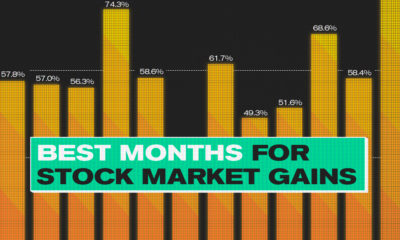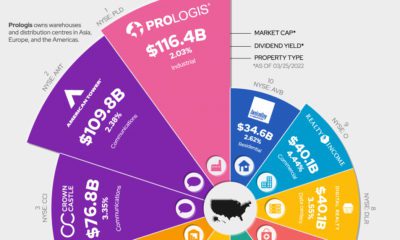29 Things to Look For in a Microcap Stock
Today’s infographic corresponds with the Howard Group’s Opportunity Knocks Challenge, which we are proud to sponsor. In this free challenge, investors can pick a portfolio of stocks from the public companies they represent – with play money of course. The investor with the best performing portfolio wins the trip of a lifetime valued between $11,000 and $15,000. There are some incredible trips available:
Head to Pamplona to literally run with the bulls Race Ferraris and Lambos in Vegas Visit exotic Vietnam and Cambodia for a river cruise Take a bite of a the Big Apple with a big shopping spree Hit the famous Wailea Golf Club in Maui for a few rounds
Definitely consider registering for this free contest today. We want to see a Visual Capitalist reader as the winner!
The Microcap Opportunity
We worked with Howard Group to come up with 29 points to consider when looking at investing in a microcap stock. The key here is due diligence. Good research can help you mitigate the risks that these stocks have. Benefits of microcaps:
Higher potential returns Small companies outperform big companies over time Valuation disconnect Lack of visibility = higher arbitrage Nimble companies and boards M&A potential
Downsides of microcaps:
Higher risk Less analyst coverage = less due diligence by market Less trading volume
Investors who do strong due diligence can mitigate the downsides to trading microcaps and can reap big gains.
Due Diligence Checklist
The People Good people behind a company make a difference – especially for small companies that have big growth potential. Here are the key things to look for:
A proven track record in building successful businesses A well-established network of connections and ability to nurture strategic relations Ability to raise capital in a tough economic environment Skin in the game: ownership of shares of the company represents real stake Management that is respectful of shareholder funds: not spending excessive money on General and Administrative (G&A) expenses or overpaying themselves
Pro tip: Review annual Information Circular for excessive levels of management compensation or director’s fees, insider shareholdings, any past bankruptcies, and other Boards that senior officers serve on or previously sat as a director. Capital Structure The structure of microcaps can tell a story on its own. Here is what to look for:
The percentage of holdings of retail vs institutional investors, as well as insiders How many shares are outstanding and fully diluted The expiry dates and strike prices of warrants
Pro Tip: Look at previous financings. Was each subsequent financing done at a higher level than the last? Or does the company have a history of dilution? The Numbers The numbers are the meat and potatoes of this checklist. Look at:
Working capital Quarterly expenses with special attention to G&A Debt – repayment schedule and interest rates Generating free cash flow, or the potential to do so in the near future Ability to maintain profitable margins
Pro Tip: Are revenues based on the one-time sale of a product or is there a strong recurring revenue model? Differentiators and Catalysts Does the company have an advantage over competitors? What catalysts are on the horizon that could potential impact share price?
What sets the company apart from its peers? Product features, attributes and benefits Service features, attributes and benefits The company’s client list Visibility on events or milestones that will bring significant shareholder value
Pro Tip: Look at management’s past performance to see if they have done what they said they’d do. Have they met the timelines and objectives previously stated? Valuation: Relative to the market, is this company fairly valued? Check out:
For a revenue producing company: how much future potential is built into the stock price versus the fundamental financial situation. For a non-revenue producing company: how much potential is built into the ultimate value of the asset and its economic viability
Tricks of the Trade: Don’t bite off more than you can chew. Could you sell your holdings within three trading days without incurring a loss greater than 10%? Keep an eye on the insiders. Insiders know the internal workings of the company and buying or selling could be a signal. Watch the stock like a hawk. A sudden price drop could indicate a pending financing or negative news. Analyze the analysts. Watch what the analysts are saying and if their opinions are shifting.
on Last year, stock and bond returns tumbled after the Federal Reserve hiked interest rates at the fastest speed in 40 years. It was the first time in decades that both asset classes posted negative annual investment returns in tandem. Over four decades, this has happened 2.4% of the time across any 12-month rolling period. To look at how various stock and bond asset allocations have performed over history—and their broader correlations—the above graphic charts their best, worst, and average returns, using data from Vanguard.
How Has Asset Allocation Impacted Returns?
Based on data between 1926 and 2019, the table below looks at the spectrum of market returns of different asset allocations:
We can see that a portfolio made entirely of stocks returned 10.3% on average, the highest across all asset allocations. Of course, this came with wider return variance, hitting an annual low of -43% and a high of 54%.
A traditional 60/40 portfolio—which has lost its luster in recent years as low interest rates have led to lower bond returns—saw an average historical return of 8.8%. As interest rates have climbed in recent years, this may widen its appeal once again as bond returns may rise.
Meanwhile, a 100% bond portfolio averaged 5.3% in annual returns over the period. Bonds typically serve as a hedge against portfolio losses thanks to their typically negative historical correlation to stocks.
A Closer Look at Historical Correlations
To understand how 2022 was an outlier in terms of asset correlations we can look at the graphic below:
The last time stocks and bonds moved together in a negative direction was in 1969. At the time, inflation was accelerating and the Fed was hiking interest rates to cool rising costs. In fact, historically, when inflation surges, stocks and bonds have often moved in similar directions. Underscoring this divergence is real interest rate volatility. When real interest rates are a driving force in the market, as we have seen in the last year, it hurts both stock and bond returns. This is because higher interest rates can reduce the future cash flows of these investments. Adding another layer is the level of risk appetite among investors. When the economic outlook is uncertain and interest rate volatility is high, investors are more likely to take risk off their portfolios and demand higher returns for taking on higher risk. This can push down equity and bond prices. On the other hand, if the economic outlook is positive, investors may be willing to take on more risk, in turn potentially boosting equity prices.
Current Investment Returns in Context
Today, financial markets are seeing sharp swings as the ripple effects of higher interest rates are sinking in. For investors, historical data provides insight on long-term asset allocation trends. Over the last century, cycles of high interest rates have come and gone. Both equity and bond investment returns have been resilient for investors who stay the course.














